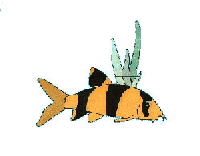ASHTABULA COUNTY AQUARIUM CLUB

By Richard Cryberg
This is a measure of the acidity or alkalinity of
water. Perfectly neutral water has a pH of 7.0. At
pH 7.0 water has an equal and tiny amount of both
acidity and alkalinity. If an acidic substance is
added to neutral water (such as pH down) it will
result in a lower pH. At pH 6.0 the concentration of
acidity is ten times as high as at pH 7.0. At pH 5.0
the concentration of acidity is ten times as high as
at pH 6.0.
Thus, in pure water it takes more acid to lower the pH
from 6.0 to 5.0 then it took to lower the same water
from 7.0 to 6.0. Our aquarium water is not pure water
though. It always has some concentration of dissolved
materials in it. Some of these dissolved materials
can act as so called buffers. A buffer simply causes
the system to resist changing pH when an acid is
added. Common buffers found in aquariums are calcium
and magnesium carbonates and bicarbonates as well as
sodium phosphates.
So, often when you add pH down to make a tank more
acidic it may take a lot to get a small initial change
then suddenly a small amount can have a larger effect.
The initial high demand is simply the amount needed
to overcome the natural buffers present. About the
only time tanks have little natural buffer present is
when they are filled with either very soft water or
reverse osmosis water.
It is actually easier to maintain pH on the slight
alkaline side then on the acidic side as there are
minerals that you can add that automatically consume
any acidity that develops in the tank. These
materials are all forms of calcium and magnesium
carbonate. Examples are limestone, dolomite, tufa
rock and shells. In a typical rift lake tank or salt
water tank you want a pH of 8.0 to 8.5. A generous
layer of such material on the tank bottom will hold
the pH in the desired region fairly automatically.
Hardness is simply a measure of the dissolved salts
present in water. Hard water has larger amounts of
dissolved salts then soft water. Most well waters in
this area as well as Lake Erie water are medium hard.
Rain water, RO water and to some extent peat treated
waters are soft. The majority of the hardness
chemicals present in local water are calcium and
magnesium carbonates and sulfates.
Most fish evolved in an environment where both pH and
hardness were fairly constant. This is particularly
true of salt water fish. Our oceans are so hugh that
they have very constant hardness and pH. Other then
fish that live right in the effluent of rivers and
streams that discharge into the ocean most salt water
fish have very low tolerance for changes in either
hardness or pH.
This tends to be less true of freshwater fish as they
live in less stable environments for the most part.
Still, each fish has its own preferences that
typically reflect the conditions where it is native.
Thus, for many of the fish we keep some adjustment of
either pH or hardness or both is needed for optimal
success.

WATER

pH
Hardness